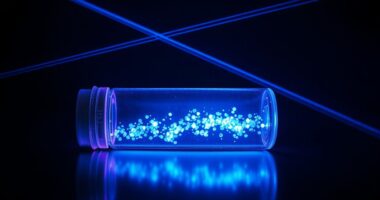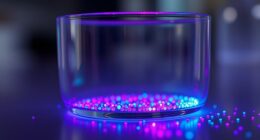When sunlight hits your plant’s leaves, chlorophyll absorbs blue and red wavelengths, starting the process of photosynthesis. This energy energizes electrons in chloroplasts, leading to the production of ATP and NADPH, which store energy. Water molecules split, releasing oxygen as a byproduct. These energy carriers then fuel the creation of glucose, supporting plant growth and oxygen supply for life on Earth. If you’re curious, you’ll discover how this amazing process transforms sunlight into plant food and energy.
Key Takeaways
- Chlorophyll absorbs blue and red light from sunlight to energize the photosynthesis process.
- Light energy excites electrons in chlorophyll, initiating reactions in the chloroplasts’ thylakoid membranes.
- The electron transport chain converts light energy into chemical energy, producing ATP and NADPH.
- Water molecules are split during photolysis, releasing oxygen as a byproduct.
- The energy carriers ATP and NADPH are used in the next stage to synthesize glucose from carbon dioxide.

Have you ever wondered how plants turn sunlight into food? It’s a fascinating process that begins with chlorophyll absorption. When sunlight hits a plant’s leaves, the chlorophyll molecules within the chloroplasts quickly absorb the light energy. Chlorophyll primarily absorbs blue and red wavelengths, which is why plants look green—because chlorophyll reflects green light instead of absorbing it. This absorption is essential because it kicks off the entire process of photosynthesis. Once chlorophyll captures the sunlight, the energy is transferred to the plant’s cells, setting the stage for the light-dependent reactions.
These reactions happen in the thylakoid membranes of the chloroplasts and rely on the energy absorbed by chlorophyll. During these reactions, sunlight energizes electrons, which are then transferred through a series of proteins called the electron transport chain. This flow of electrons helps generate two critical molecules: ATP (adenosine triphosphate) and NADPH (nicotinamide adenine dinucleotide phosphate). Both are energy carriers that will be used later to produce glucose. The process also involves splitting water molecules—a step known as photolysis—to release oxygen, protons, and electrons. The electrons replenish those lost by chlorophyll, ensuring the reactions keep running smoothly. The oxygen produced is released into the atmosphere as a byproduct, supporting life on Earth.
Additionally, understanding environmental considerations is important for sustainable practices in nature. The light-dependent reactions are fundamentally the energy-harvesting part of photosynthesis. They require sunlight to activate the chlorophyll molecules, kickstarting the flow of electrons and the production of ATP and NADPH. These molecules then serve as “fuel” for the next stage—light-independent reactions, which convert carbon dioxide into glucose. Without this initial step of chlorophyll absorption and the subsequent reactions, the entire process would grind to a halt. It’s a beautifully coordinated system where sunlight provides the energy, chlorophyll captures it, and the plant uses that energy to build the food it needs to grow.
Frequently Asked Questions
How Do Different Light Colors Affect Photosynthesis Efficiency?
Different light colors in the spectrum impact your plant’s photosynthesis efficiency because chlorophyll absorbs mainly blue and red light. When you provide these wavelengths, your plant can maximize energy absorption and produce more sugars. Green light is less effective because chlorophyll reflects it. So, to boost photosynthesis, guarantee your light source emits a balanced spectrum with ample blue and red wavelengths, optimizing chlorophyll absorption and overall plant growth.
Can Plants Perform Photosynthesis in Artificial Light Environments?
Sure, plants can perform photosynthesis in artificial lighting, though you might think they’d prefer natural sunlight. By using artificial lighting, you can boost photosynthesis efficiency, especially indoors or in low-light environments. LED grow lights, for instance, provide the specific light spectra plants need, making it possible to grow healthy, thriving plants without sunlight. So, yes, your green friends aren’t too picky—they’ll adapt to artificial lighting just fine.
What Role Do Pigments Other Than Chlorophyll Play in Photosynthesis?
You should know that accessory pigments, like carotenoids and anthocyanins, play a vital role in photosynthesis by capturing additional light energy. These pigments extend the range of light wavelengths the plant can use, supplementing chlorophyll’s function. Their main pigment functions include protecting the plant from damage by excess light and transferring absorbed light energy to chlorophyll for efficient photosynthesis, making the process more effective overall.
How Does Photosynthesis Vary Among Different Plant Species?
Imagine a symphony of life, where each plant adapts uniquely. You’ll find photosynthesis varies among species because of plant adaptation, shaped by their environment. For example, some plants have specialized pigments, like carotenoids, to capture different light spectra, reflecting species diversity. These adaptations optimize energy capture, allowing plants to thrive in diverse conditions—from deep shade to arid deserts—showing nature’s incredible ability to tailor photosynthesis to each species’ needs.
Are There Any Environmental Conditions That Completely Inhibit Photosynthesis?
Environmental stress can cause a complete photosynthesis shutdown in plants. Conditions like extreme drought, flooding, intense heat, or severe cold hinder the process by damaging chloroplasts or disrupting enzyme functions. When these stresses become severe, plants can’t produce the energy they need, leading to halted growth or even death. You should protect plants from such conditions or adapt your gardening practices to minimize environmental stress and keep photosynthesis ongoing.
Conclusion
Now that you understand how plants turn light into energy, you see how essential they are to life on Earth. Photosynthesis is their secret weapon, fueling ecosystems and providing oxygen for us all. Remember, every leaf has a story to tell, and you just need to look a little closer. Don’t forget, the devil’s in the details—so pay attention to nature’s quiet miracles. By appreciating this process, you gain a new respect for the green world around you.









